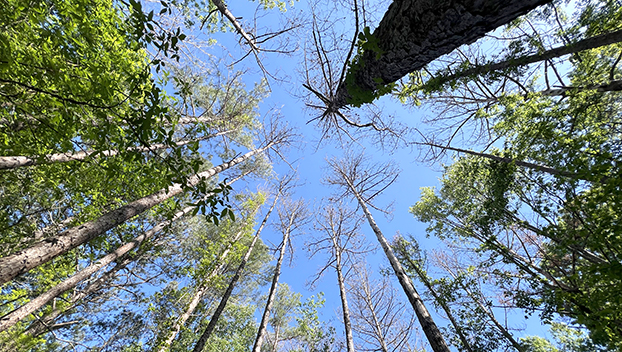Disaster aid eligibility expanded to foresters
Published 4:10 pm Saturday, April 20, 2024

- Looking up, drought and bug killed pine trees have cast their needles. The bark is starting to fall away and eventually the dead tree will fall down. USDA approved funding for forest restoration following the drought. (Hunter Cloud | The Daily Leader)
STARKVILLE — Forest landowners in Mississippi can now join the state’s farm owners who suffered production loss due to last year’s drought in applying for federal emergency loans.
U.S. Secretary of Agriculture Tom Vilsack approved a legislative request to approve Emergency Forest Restoration Program funding, or EFRP, for eligible forest landowners on April 15. He initially designated all 82 Mississippi counties as natural disaster areas on March 25 related to the drought. Farm operators seeking emergency aid through the U.S. Department of Agriculture Farm Service Agency, or FSA, now have just over seven months to apply.
Nearly 80,000 acres of the state’s pine trees were damaged in 2023 by the drought and ensuing pine bark beetle infestations, according to a preliminary report from the Mississippi Forestry Commission and the USDA Forest Service, Southern Research Station. Affected timber managers can apply for financial relief through EFRP until Aug. 15.
Forest landowners whose EFRP applications are accepted can be reimbursed for up to 75% of the estimated monetary loss after they have successfully documented the scope of the restoration work. The minimum eligible restoration cost for participation is $1,000, with no minimum acreage requirement. The program’s payment limitation is $500,000.
Curtis VanderSchaaf, forestry specialist for the Mississippi State University Extension Service, said the cost-share reimbursement program can help timber managers restore forests compromised last year by drought stress and Ips beetles.
“Landowners need to make sure that they keep excellent records of their costs related to debris removal, replanting and forest protection activities for reimbursement purposes,” VanderSchaaf said. “Landowners should check to see if any of the cost-share reimbursement can be excluded from their gross income for income tax purposes.
“If these funds are used in any part for planting,” he added, “these cost shares may inadvertently limit the applicability of the Federal Reforestation Tax Deduction and Amortization provisions and Mississippi Reforestation Tax credit to these same acres.”
More information on each of the USDA disaster assistance programs is available online at https://www.farmers.gov/protection-recovery/drought.
“Disaster programs are there to help producers in times of widespread damage,” said Brian Mills, an agricultural economist with MSU Extension. “Payments provided by these programs typically depend not only on the severity of the damages but also on how many producers report them, so it is important that they document their losses to the FSA and apply for disaster relief to get as much support as possible.”





